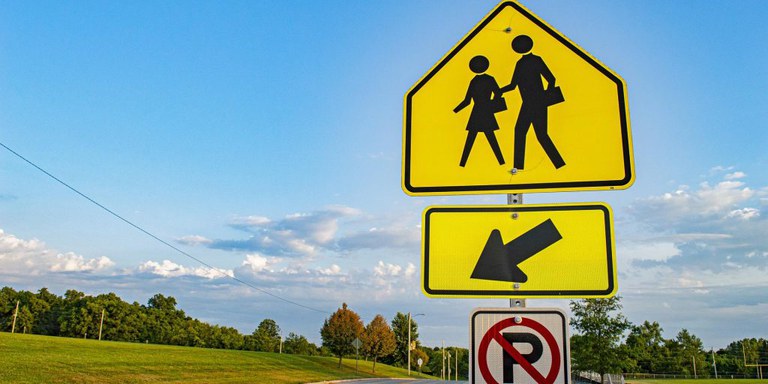Making school zones safer for students and pedestrians
Traffic Safety Pulse News
For the past decade, pedestrian fatalities and injuries due to speed-related vehicle accidents have been on the rise. Sadly, an alarming number of those injuries have occurred in school zones. According to the Transportation Research Board, 25,000 children are injured annually and more than 100 killed on average while walking to or from school, all as a result of speeding.

While there is certainly no excuse for this, it is not surprising. According to Safe Kids Worldwide, half of all school zones in the U.S. have speed limits above 20 miles per hour, while 30 percent lack marked crosswalks. Couple these statistics with the unusually high levels of vehicle, pedestrian and cyclist activity in the immediate vicinity of schools during student drop-off and pick-up times and you have a recipe for disaster.
Clearly, school leaders, and by extension civic leaders and communities in general, must do more to reduce roadway fatalities and increase school zone safety. But it is not as easy as simply adopting a more stringent vehicle management policy. School zones are unique and the accidents that happen near schools differ from traditional pedestrian accident cases in a number of ways. For starters, most accidents are likely to occur on weekdays (specifically Wednesdays) rather than weekends. Accidents also happen most frequently during the day when lighting is bright and clear, as opposed to nighttime when visibility is reduced.
So what can be done to increase safety and save the lives of our country’s schoolchildren? Perhaps the most effective countermeasure is the implementation of traffic calming tactics—physical measures that are designed to create safe streets by slowing drivers down, lowering collision frequency and severity, and reducing the need for police enforcement while increasing access for different modes of transport. The most commonly used of these measures include:
- Enhanced delineation: Also known as “rumble strips,” these high-friction surface treatments can allow for a 52 percent reduction in wet road crashes. On curves, the high-friction surface treatments can have a 24 percent reduction in curve crashes.
- Roadside improvements: Improvements can significantly reduce fatal crashes at curves, where 27 percent of all fatal crashes occur. Shockingly, 80 percent of all fatal crashes at curves are roadway departure crashes.
- Traffic signals: Backplates with reflective borders can reduce crashes by 15 percent. Backplates added to a traffic signal indication improve the visibility of the illuminated face of the signal by introducing a controlled contrast background.
- Access management: Proper corridor access management can reduce total crashes along two-lane rural roads by up to 23 percent and can produce up to a 31 percent reduction in injury and fatal crashes along urban and suburban arterials.
- Turn lanes: Auxiliary turn lanes for left or right turns provide physical separation between turning traffic that is slowing or stopped and adjacent thru traffic at approaches to intersections. Left and right turn lanes could reduce total crashes by 48 percent for left turn lanes and 26 percent for right turn lanes.
- Roundabouts: The modern roundabout is a type of circular intersection configuration that safely and efficiently moves traffic thru an intersection. Changing a signalized intersection to a roundabout can reduce severe crashes by up to 78 percent.
- Road diets: A road diet typically involves converting an existing four-lane divided roadway to a three-lane roadway consisting of two thru lanes and a center, two-way left turn lane. A low-cost safety solution when planned in conjunction with a simple pavement overlay, a road diet can reduce crashes by as much as 47 percent.
Beyond those measures, speed cameras are one of the best methods for slowing cars. While most people are not wild about speed cameras, the reality is that they help to encourage motorists to slow down, particularly in high-risk areas such as school zones. In New York City, for example, speeding at fixed speed camera locations has dropped 72 percent on average. Crashes with injuries dropped 8 percent during hours of speed camera operation.
Throughout 2021, New York’s Department of Transportation installed an average of 60 new cameras per month, with the aim of reaching a total of 2,220 cameras this year. New York leaders are also working to change the state law to permit 24/7 operation of speed cameras in school zones, which will likely save more lives. Current hours of operation permitted by state law indicate a pattern of relatively less speeding during camera hours of operation, and a higher proportion of vehicles speeding when the cameras are forbidden by law to issue violations.
Further underscoring this point, a CDC report entitled “Automated Speed-Camera Enforcement” found that speed cameras reduced total crashes anywhere from 8 percent to 49 percent, and fatal and serious-injury crashes from 11 percent to 44 percent in studies that compared pre- and post-crash data collected near camera sites.
Ultimately, implementing such measures will make our schools and schoolchildren safer and help communities nationwide to advance Vision Zero, a movement to end all traffic-related fatalities and serious injuries by taking a systematic approach to road safety. If there is truly a desire to implement Vision Zero, though, school officials, communities, and municipalities must be serious about, and committed to, implementing Vision Zero policies, procedures, and design. Money and funding must be allocated. What remains unclear is how many Americans are prepared to fight to ensure that Vision Zero promises translate into action. Otherwise Vision Zero within school zones throughout the country is likely to remain just that, “a vision.”
To read the full article, visit americancityandcounty.com/2022/07/20/making-school-zones-safer-for-students-and-pedestrians/
Wes Guckert, PTP is president and CEO of The Traffic Group, a leading Service Disabled Veteran-Owned Small Business traffic engineering and transportation planning firm serving clients nationally and internationally. He is also a fellow of ITE and on the National Small Business Leadership Council.
